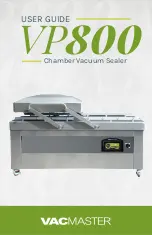
IT IS IMPORTANT TO READ & UNDERSTAND all of the instructions and
safeguards prior to using the Dehydrator.
1. Operate the Dehydrator on a clean, dry AND LEVEL surface.
2. Plug the Dehydrator into a standard 120 Volt, 60 Hz wall outlet.
3. Position the Dehydrator at least 12” (30.5 cm) from any wall during operation
to allow for proper air circulation. WARNING! DO NOT block the air vents at the
bottom of the Dehydrator.
4. Turn the Dehydrator to the ON position. When on, the light should illuminate the
Power Switch.
5. Load the Trays with the items to be dried. Lay foods flat on the Trays. Position
the pieces so that they do not touch each other. Do not overlap or allow the product
to touch. Allow ample space between the products for proper air circulation. Do not
place items to be dried on the Base, there will be no circulation of air on this Base.
6. Stack the loaded Trays onto the Base. Place the Lid onto the top Tray (
FIGURE
3).
7. Remove any excess water from the food (this can be done by patting the
food with a paper towel or napkin). Excess moisture may cause the Dehydrator
temperature to drop.
8. Water droplets may form on the surface of some products while dehydrating.
Periodically blot the product with a clean paper towel.
NOTE: Drying times may vary based on many circumstances including
but not limited to: the relative humidity of the room, the temperature of
the food at the beginning of the drying process, the amount of food in
the Dehydrator, the leanness of the meat, etc.
9. After one hour of dehydrating, use a spatula and
flip the food. Flip the food often until it is no longer
sticky.
10. Check dryness after a few hours, then check
every two hours until dehydrated. Open or cut down
the middle if a few samples to check internal dryness.
If the food is still moist, dehydrate longer. Carefully
remove the food from the Trays when drying is
complete.
11. When finished drying, turn the Dehydrator OFF
and unplug from the power source. Allow the Trays
and the Base to cool before cleaning.
IMPORTANT NOTE: DO NOT run the Dehydrator for
more than 24 hours at a time. After 24 hours,turn the
Dehydrator OFF and unplug from the power source.
Allow the Trays and the Base to cool for at least 2
hours before resuming operation.
OPERATING INSTRUCTIONS
FIGURE 3
6
ENGLISH INSTRUCTIONS
7
ENGLISH INSTRUCTIONS
As with most types of cooking, proper preparation is essential for successful
results. Adhering to a few basic guidelines will greatly increase the quality of
your dried foods and decrease the amount of time necessary to dry them.
Pre-treated foods often taste better and have a better appearance than
non-treated foods. There are several methods to pre-treat food to prevent
oxidation, which will darken apples, pears, peaches and bananas while
drying:
• Remove any pits, skin or cores.
• Shred, slice or dice the food uniformly. Slices should be between 1/4” (0.6
cm) and 3/4” (1.9 cm) thick. Meats should be cut no more than 3/16” (0.5
cm) thick.
• Steam or roast meat to 160˚F (71
o
C) and poultry to 165˚F (74
o
C) as
measured with a food thermometer before dehydrating.
• The temperature of the Dehydrator must be maintained at 130-140˚F (55-
60
o
C) throughout the drying process.
• Drying fish into jerky requires a lot of attention. It must be cleaned and de-
boned properly and rinsed thoroughly to ensure that all the blood is washed
away. Steam or bake the fish at 200˚F (93
o
C) until flaky before dehydrating.
• Soak cut fruit in either lemon or pineapple juice for a few minutes before
placing out on the Dehydrating Trays.
• Use an ascorbic acid mix which can be purchased in most health food
stores or pharmacies. It may come in either powder or tablet form. Dissolve
approximately 2-3 tablespoons into 1 quart (1 liter) of water. Soak the fruit
slices into the solution for 2-3 minutes, then place on the Dehydrating Trays.
• Fruits with a wax coating (figs, peaches, grapes, blueberries, prunes, etc.)
should be dipped in boiling water to remove the wax. This allows moisture to
escape easily when dehydrating.
• Blanching can pre-treat food for dehydrating. Blanching does not destroy
helpful enzymes and helps retain nutrients. There are two ways to blanch
food:
1. WATER BLANCHING: (Water Blanching will leave a cooked
flavor)Use a large pan; fill it half way with water. Bring water to a
boil. Place food directly into boiling water and cover. Remove after
three minutes. Arrange food on the Dehydrating Trays.
2. STEAM BLANCHING: Using steamer pot bring 2-3” (5-7 cm)
of water to a boil in bottom section. Place food in steamer basket
and steam for 3-5 minutes. Remove steamed food and arrange on
Dehydrating Trays.
PRE-TREATMENT OF FOODS





































